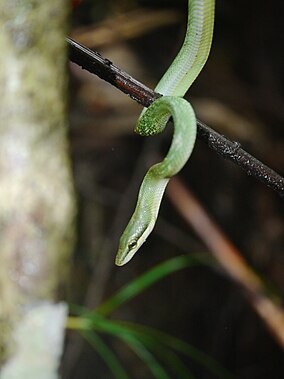Dehing Patkai National Park
This article needs additional citations for verification. (August 2012) |
| Dehing Patkai National Park | |
|---|---|
 Young Green Trinket Snake in Dehing Patkai National Park | |
| Lua error in Module:Location_map at line 403: attempt to index field 'wikibase' (a nil value). | |
| Location | Dibrugarh and Tinsukia, Assam |
| Nearest city | Khonsa, Naharkatia, Duliajan, Dibrugarh |
| Area | 231.65 km2 (89.44 sq mi) |
| Established | 2004 |
| Governing body | Government of Assam |
Dehing Patkai National Park is located in the Dibrugarh and Tinsukia districts of Assam and covers an area of 231.65 km2 (89.44 sq mi) rainforest.[1][2] It was declared a wildlife sanctuary on 13 June 2004. On 13 December 2020 Government of Assam upgraded it into a national park.[3] On 9 June 2021 Forest Department of Assam officially notified it as a national park.[4] It is located in the Dehing patkai landscape which is a dipterocarp-dominated lowland rainforest. The rainforest stretches for more than 575 km2 (222 sq mi) in the districts of Dibrugarh, Tinsukia and Charaideo. The forest further spreads over in the Tirap and Changlang districts of Arunachal Pradesh. The Dehing Patkai forms the largest stretch of lowland rainforests in India. The Dehing Patkai Wildlife Sanctuary was declared as Dehing-Patkai Elephant Reserve under Project Elephant.[5][6]
Climate[edit]
The climate of the region is mostly tropical with an annual rainfall of more than 4,000 mm. Monthly precipitation is at least 60 mm.[citation needed]
Wildlife[edit]
Fauna[edit]
Being a completely virgin rainforest, this National Park is very rich in biodiversity. It is an ideal habitat for non-human primates. Till date, 47 mammal species, 47 reptile species and 310 butterfly species have been recorded. The most common mammal species of this National Park are hoolock gibbon, slow loris, Assamese macaque, stump-tailed macaque, capped langur, Asian elephant, Bengal tiger, Indian leopard, gaur, Chinese pangolin, Himalayan black bear, Red giant flying squirrel, leopard cat, clouded leopard, porcupine, crab eating mongoose, sambar, sun bear, binturong, barking deer, Asian golden cat and marbled cat.[7]
Avifauna[edit]
This section possibly contains original research. (May 2017) |

Dehing Patkai rainforest harbours about 293 bird species, belonging to 174 genera and 51 families. The majority is resident (63.7%), some are winter visitors (23.1% ), and very few are summer visitors (2.5%). About 10.7% are altitudinal migrants, coming mainly from the higher reaches of the western, central and eastern Himalayas. Avifauna includes slender-billed vulture, white-winged duck, greater adjutant, lesser adjutant, greater spotted eagle, yellow-vented warbler, broad-billed warbler, white-naped yuhina, white-cheeked partridge, great hornbill, brown hornbill, Oriental darter, osprey, kalij pheasant, grey peacock pheasant, besra, black baza and hill myna.
Flora[edit]
This section does not cite any sources. (May 2020) |
The different trees of this four-layered rainforest are laden with many exotic species of orchids and bromeliads. There is an abundance of ferns, epiphytes, wild banana, orchids, arums, climbers and lianas in this humid forest habitat. Some of the important tree species found in this forest area are – Hollong, Mekai, Dhuna, Uriyam, Nahar, Samkothal, Bheer, Hollock, Nahor, Au– tenga (elephant apple), different species of Dimoru etc. The towering Hollong tree which is also the state tree of Assam dominates the emergent layer of this rainforest.
The forests are wet tropical evergreen Assam valley forests.
The important species of over wood are Dipterocarpus macrocarpus, Mesua ferrea, Castanopsis indica, Shorea assamica, Vatica lanceaefolia, Amoora wallichii, Dysoxylum binectiferum etc. The other species found in understorey are Garcinia lanceifolia, Michelia muni, Baccaurea sapida, Bischofia javanica, Myristica limifolia etc. The shrub and herb layer has Glochidion spp., Alpinia spp., Mallotus philippinensis, wild banana, tree fern, pepper etc. The ground cover mainly has Melastoma, Leea and other species.
Ethnic groups[edit]
The Dehing Patkai Forest region has a rich cultural heritage. There are more than a dozen different ethnic groups living in the area including the indigenous Assamese communities, particularly Tai Phake, Khamyang, Khampti, Singpho, Nocte, Chutia, Ahom, Kaibarta, Moran , Motok, Burmese, and Nepali people. Tea-tribes were brought by the British to work in the tea plantations.[citation needed]
References[edit]
- ↑ Chakraborty, Avik (7 December 2020). "Environmentalist hails Assam government's decision to upgrade Dihing Patkai Wildlife Sanctuary into national park". nenow.in. Northeast Now. Retrieved 14 December 2020.
- ↑ Dehing Patkai Wildlife Sanctuaries Archived 17 May 2013 at the Wayback Machine Department of Environment & Forests, Government of Assam, Retrieved 2 September 2015
- ↑ Bureau, Pratidin (14 December 2020). "Dehing Patkai Upgraded to National Park". pratidintime.com. Pratidin Time. Retrieved 14 December 2020.
- ↑ Bureau, Pratidin (9 June 2021). "Dehing Patkai Declared National Park, 7th in Assam". pratidintime.com. Pratidin Time. Retrieved 9 June 2021.
- ↑ Bhattacharjee, J. (2013). "Exploring Environmental Movements in Assam: Some Case Studies" (PDF). Environmental activism in North East India: exploring environmental movements and action groups with special reference to Assam (PhD thesis). New Delhi: Jawaharlal Nehru University. pp. 91–118.
- ↑ Sharma, N. (2020). "Dehing Patkai: A survivor once again". The Hill Times. Vol. XXI, no. 151. p. 4.
- ↑ Choudhury, A. U. (2013). The mammals of North East India. Guwahati: Gibbon Books and the Rhino Foundation for Nature in NE India. ISBN 938065202X.
